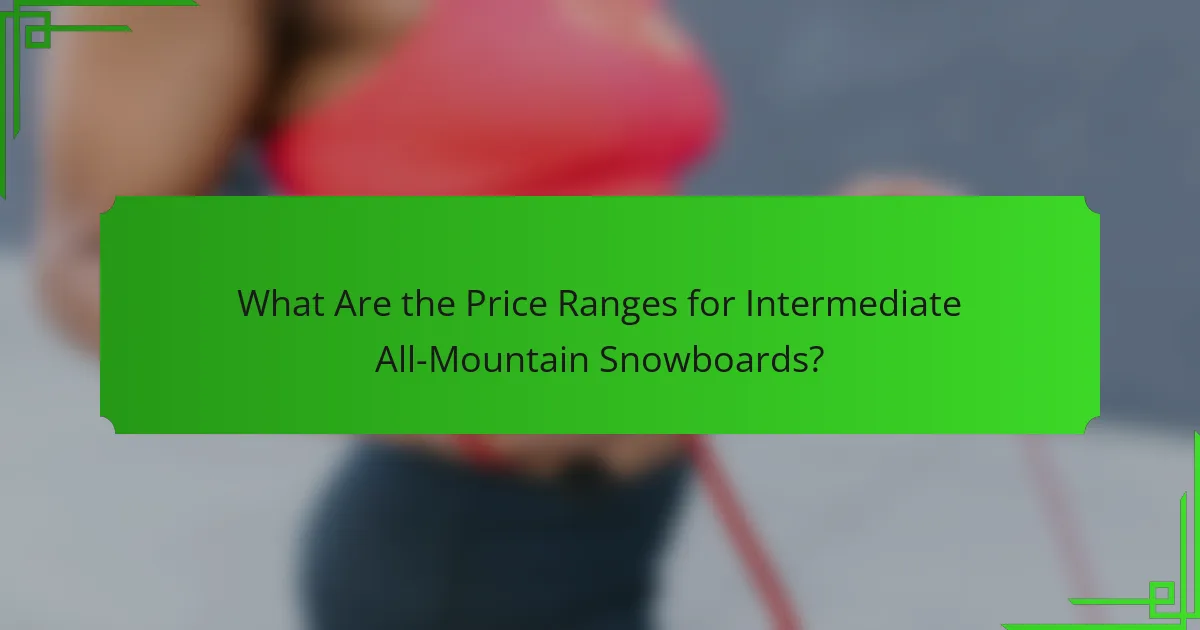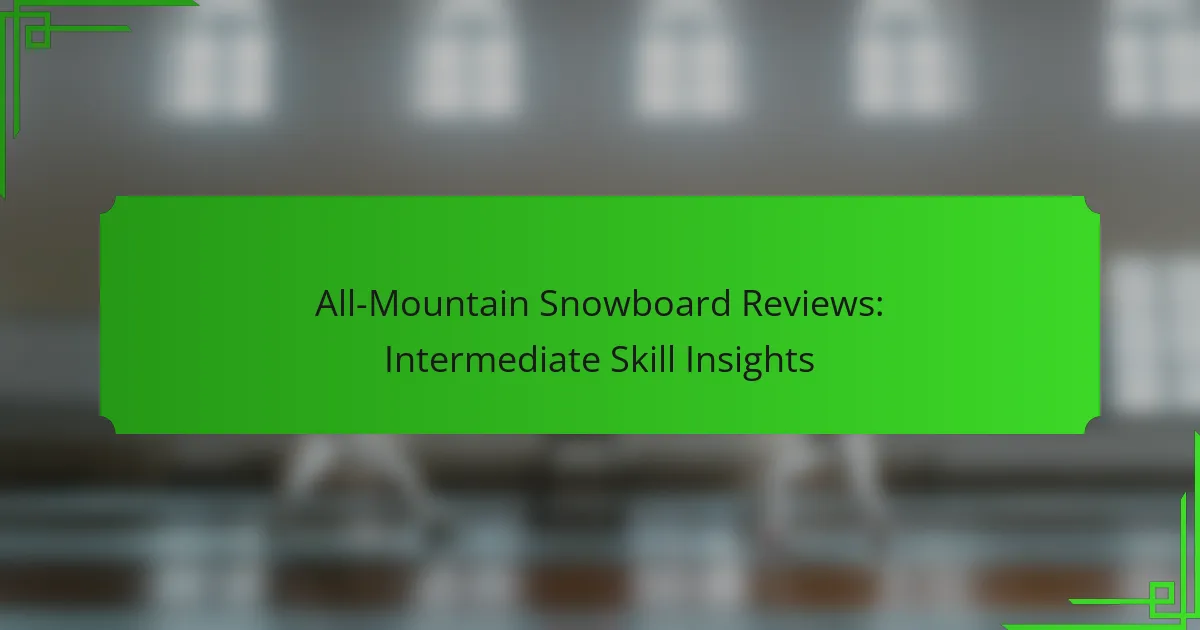For intermediate snowboarders, selecting the right all-mountain board is crucial for enhancing skills and enjoying diverse riding experiences. These boards offer a perfect blend of versatility and performance, allowing riders to tackle various terrains with confidence. By considering factors such as riding style, board flex, and shape, you can find a snowboard that complements your growth on the slopes.

What Are the Best All-Mountain Snowboards for Intermediate Riders?
The best all-mountain snowboards for intermediate riders balance versatility, performance, and ease of use. These boards are designed to handle various terrains and conditions, making them ideal for those looking to improve their skills while enjoying different riding styles.
Burton Custom Flying V
The Burton Custom Flying V is a hybrid board that combines rocker and camber profiles, providing a playful ride while maintaining stability. This versatility makes it suitable for both groomed runs and powder days, allowing intermediate riders to explore various terrains confidently.
With its lightweight construction and responsive flex, the Custom Flying V enhances maneuverability, making it easier to navigate tight turns. Riders appreciate its forgiving nature, which helps build confidence as they progress in their skills.
Lib Tech T.Rice Pro
The Lib Tech T.Rice Pro is a high-performance all-mountain snowboard favored by many intermediate riders for its stability and edge control. Featuring a directional shape and a hybrid camber profile, this board excels in both powder and on-piste conditions.
Its eco-friendly construction and durable materials ensure longevity, making it a worthwhile investment. Riders can expect a smooth ride with excellent pop, allowing for fun jumps and tricks as they advance their abilities.
Salomon Assassin
The Salomon Assassin is designed for versatility, making it an excellent choice for intermediate snowboarders looking to tackle various terrains. Its twin shape and rocker profile provide a balanced ride, allowing for easy transitions between freestyle and freeride styles.
This board is known for its stability at high speeds and responsiveness in turns, which helps riders feel secure as they push their limits. The Assassin’s construction also offers a forgiving flex, perfect for those still honing their skills.
Ride Warpig
The Ride Warpig is a unique all-mountain snowboard that stands out for its short, wide design, making it highly maneuverable. This board is particularly suited for intermediate riders who want to experiment with different riding styles without sacrificing performance.
Its versatile shape allows for quick turns and stability in various conditions, from groomed runs to powder. The Warpig’s playful nature encourages creativity, making it a fun option for those looking to progress in their riding techniques.
K2 Raygun
The K2 Raygun is an approachable all-mountain snowboard that excels in versatility and ease of use, making it ideal for intermediate riders. With a directional shape and a rocker profile, it provides a smooth ride across different terrains, allowing riders to gain confidence in various conditions.
This board’s forgiving flex and lightweight construction make it easy to maneuver, helping riders improve their skills without feeling overwhelmed. The Raygun is a great choice for those looking to explore the mountain while refining their technique.

How to Choose an All-Mountain Snowboard?
Choosing an all-mountain snowboard involves understanding your riding style, evaluating board flex and shape, and ensuring compatibility with bindings. These factors will help you select a board that enhances your performance across various terrains.
Consider your riding style
Your riding style significantly influences the type of all-mountain snowboard you should choose. If you prefer freestyle, look for a board with a softer flex and a twin shape for better maneuverability. For those who enjoy carving or powder, a stiffer board with a directional shape may be more suitable.
Think about where you spend most of your time on the mountain. If you frequently ride in parks, opt for a board designed for tricks. Conversely, if you favor backcountry or groomed runs, choose one that excels in stability and control.
Evaluate board flex and shape
Board flex refers to how much a snowboard bends, which affects its performance. Softer boards are more forgiving and easier to control, making them ideal for beginners and park riders. Stiffer boards offer better edge hold and stability at high speeds, which is beneficial for advanced riders.
The shape of the board also plays a crucial role. Common shapes include directional, twin, and directional twin. A directional board is best for those who primarily ride in one direction, while twin shapes are versatile for riders who switch between regular and goofy stances.
Check compatibility with bindings
Ensuring your snowboard is compatible with your bindings is essential for optimal performance. Most boards use standard mounting systems, but it’s wise to verify that your bindings fit the board’s specifications. Look for boards with a 4-hole pattern, as they are widely compatible.
Additionally, consider the flex of your bindings in relation to the board. A stiffer board pairs well with stiffer bindings for better response, while a softer board is complemented by more flexible bindings for a playful ride. Always check manufacturer guidelines for compatibility to avoid issues on the slopes.

What Are the Key Features of All-Mountain Snowboards?
All-mountain snowboards are designed to perform well across various terrains and conditions, making them suitable for intermediate riders. Key features include versatile designs, hybrid camber profiles, and durable materials that enhance performance and longevity.
Versatile design
The versatile design of all-mountain snowboards allows them to handle a wide range of snow conditions, from powder to groomed runs. This adaptability is crucial for intermediate riders who want to explore different terrains without switching boards.
When choosing a board, look for a directional twin shape or a true twin shape, as these designs provide stability and maneuverability. A board with a medium flex is often ideal for balancing comfort and responsiveness.
Hybrid camber profiles
Hybrid camber profiles combine traditional camber with rocker or flat sections, offering the best of both worlds. This design helps with edge control and stability while also providing float in powder, which is beneficial for intermediate riders looking to progress.
Consider boards with a rocker-camber-rocker profile for versatility. This setup allows for easy turns while maintaining grip on hardpack snow, making it easier to navigate various terrains.
Durable materials
Durable materials are essential for all-mountain snowboards, as they endure diverse conditions and impacts. Look for boards made with high-quality wood cores, reinforced edges, and tough topsheets to ensure longevity.
Common materials include sintered bases, which offer better speed and durability compared to extruded bases. Investing in a board with these features can enhance your riding experience and reduce the need for frequent repairs or replacements.

What Are the Price Ranges for Intermediate All-Mountain Snowboards?
Intermediate all-mountain snowboards typically range from around $300 to over $800, depending on the features and brand. Understanding these price tiers can help you make an informed decision based on your skill level and budget.
Entry-level: $300-$500
When shopping in this range, look for boards that offer good durability and versatility. Brands like Burton and K2 often have solid options that balance performance with affordability.
Mid-range: $500-$800
The mid-range category, priced between $500 and $800, offers boards with enhanced performance features suitable for intermediate riders. These boards typically have a stiffer flex, improved materials, and better edge hold, allowing for more aggressive riding.
In this price bracket, you can expect to find options with advanced technology, such as hybrid camber profiles and lighter materials. Brands like Ride and Lib Tech provide excellent choices that cater to a variety of riding styles.
High-end: $800+
High-end all-mountain snowboards, priced at $800 and above, are aimed at serious riders looking for top-tier performance and durability. These boards often incorporate the latest technology and premium materials, resulting in superior responsiveness and stability.
Investing in a high-end board can significantly enhance your riding experience, especially in challenging conditions. Brands like Jones and Never Summer are known for their high-quality offerings that can withstand rigorous use while providing exceptional performance.

What Are the Common Mistakes When Buying All-Mountain Snowboards?
Common mistakes when buying all-mountain snowboards include overlooking skill level, neglecting the right board size, and failing to consider terrain preferences. These factors significantly influence performance and overall enjoyment on the slopes.
Ignoring skill level
Ignoring skill level is a frequent mistake that can lead to poor snowboard choices. Intermediate riders should select boards that offer a balance of stability and maneuverability, which enhances their ability to progress without feeling overwhelmed.
For intermediate snowboarders, boards with a medium flex are often ideal. They provide enough support for varied terrain while allowing for easier turns and tricks. Choosing a board that is too advanced can hinder development and lead to frustration.
Consider testing different boards at a local rental shop to find the right fit for your skill level. This hands-on experience can help you identify what feels comfortable and aligns with your riding style.
